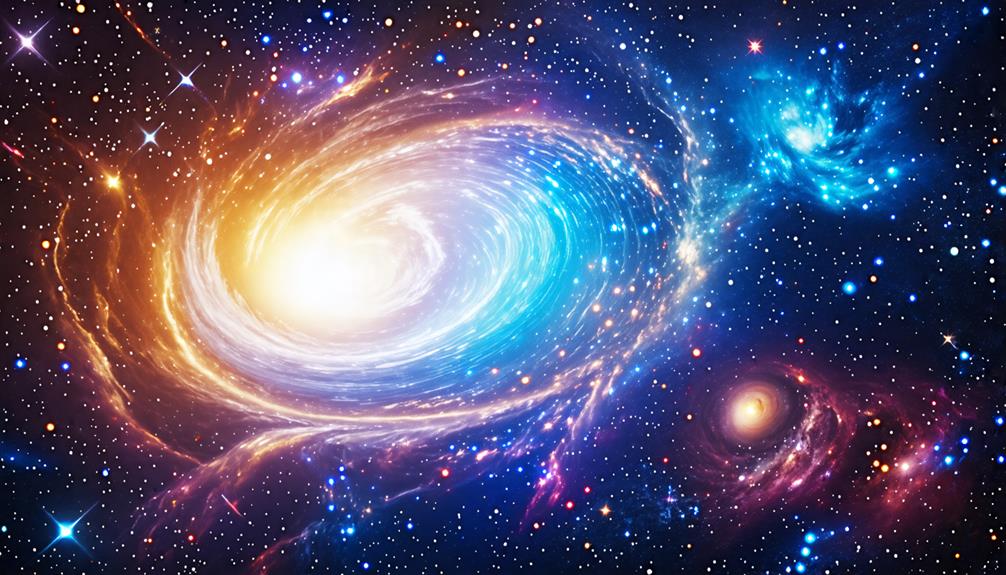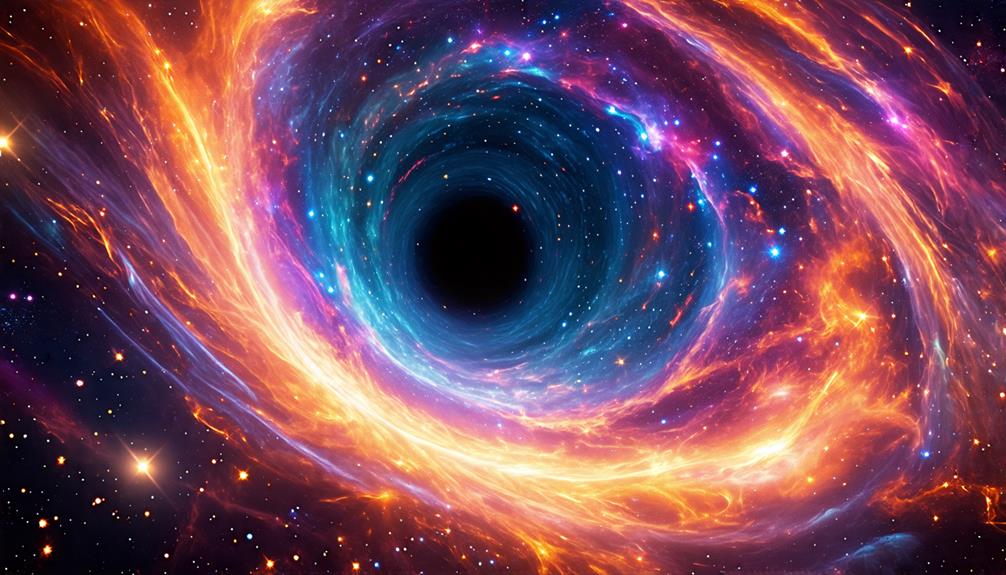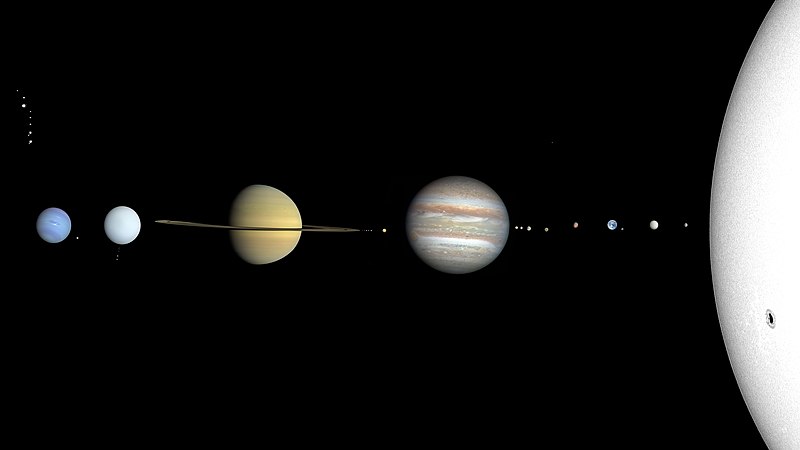What Makes Black Hole Collisions So Rare?
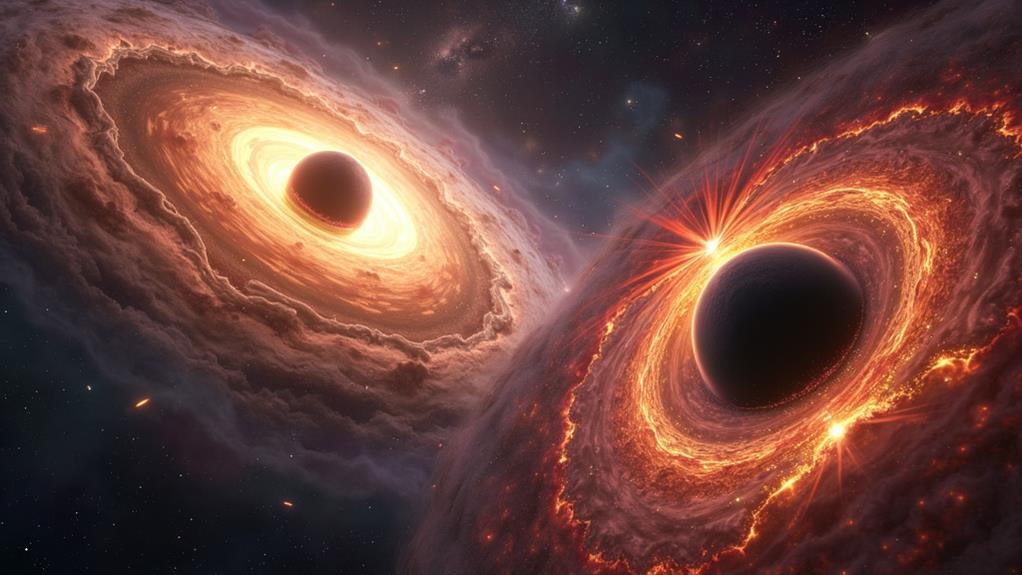
Black hole collisions are incredibly rare due to the specific conditions required for them to occur. You need black holes to form from massive stars in low-metallicity environments and to be initially close enough for gravitational interactions to bring them together. The "final parsec problem" further complicates the merger of supermassive black holes by stalling their coalescence. Add to that the challenge of detecting faint gravitational waves across billions of light years with advanced detectors like LIGO. All these factors make black hole collisions extraordinary events. Uncover what's behind these cosmic phenomena and their immense impact on our understanding of the universe.
Key Takeaways
- Black hole collisions require stars to be extremely close, within a fifth of the Earth-Sun distance.
- Low-metallicity environments, necessary for black hole formation, are relatively rare in the universe.
- Gravitational waves from black hole mergers are faint, requiring advanced detection technology like LIGO.
- The final parsec problem complicates the merging process of supermassive black holes, causing them to stall at close distances.
- Initial proximity of black holes is rare, making the events of gravitational interactions that lead to mergers infrequent.
Gravitational Waves Discovery
In 2015, the Laser Interferometer Gravitational-Wave Observatory (LIGO) made a groundbreaking revelation by detecting gravitational waves for the initial time. This detection confirmed the existence of black hole collisions, originating from events 1.3 billion light years away. Gravitational waves are ripples in space and time caused by massive objects, particularly during black hole mergers. These waves validate Einstein's General Theory of relativity and offer a new way to observe the universe.
LIGO's finding of these gravitational waves signaled that merging black holes emit energy exceeding that of all stars combined. Since its inception, LIGO has detected ten black hole mergers, marking a significant advancement in our understanding of these cosmic phenomena. Each of these detections has been documented in the Astrophysical Journal Letters, providing vital insights into the dynamics of colliding black holes.
The emission of gravitational waves from these events allows scientists to study the fabric of space and time in unprecedented detail. These phenomena contribute to a background noise in the universe, and ongoing research aims to detect supplementary signals from supermassive black hole mergers. Through these revelations, we're gaining a deeper understanding of how black holes interact and merge on a cosmic scale.
Black Hole Formation
Building on the finding of gravitational waves from black hole collisions, it's essential to understand how these cosmic giants come into existence. Black hole formation starts with the collapse of massive stars. For a star to evolve into a black hole, it needs to be at least 20 times the mass of the Sun. This dramatic transformation typically happens during a supernova explosion, leading to the birth of a stellar-mass black hole in seconds.
Specific conditions are necessary for these stellar giants to eventually merge:
- Proximity: Stars need to start close together, within a fifth of the Earth-Sun distance, to facilitate future mergers.
- Environment: Low-metallicity environments, containing less than 0.1% of elements, are ideal for forming merging black holes.
- Growth: While stellar-mass black holes form quickly, supermassive black holes grow over less than a billion years through the merging of smaller black holes.
- Modeling: The COMPAS model helps analyze black hole progenitors, revealing mass transfer episodes even between widely separated stars.
Merger Dynamics
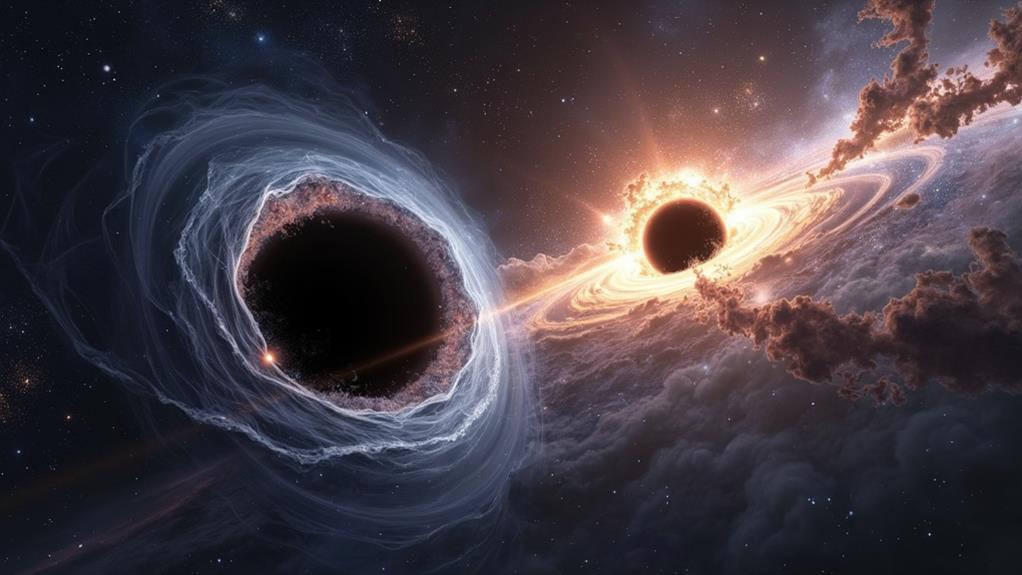
When black holes ultimately come together, the dynamics of their merger are nothing short of spectacular. Black holes must start very close together, within a fifth of the Earth-Sun distance, to eventually collide. This initial proximity is incredibly rare, making black hole mergers an infrequent phenomenon.
The path to a merger involves complex gravitational interactions. Massive progenitor stars undergo mass transfer as they expand, altering the orbital energy and bringing black holes closer over millions of years. These changes in orbital energy are essential, but the actual merging process happens relatively quickly compared to the long formation times.
Gravitational interactions play a significant role in the merger dynamics. Gas ejection events reduce orbital energy, facilitating the concluding stages of merging. When black holes ultimately collide, they produce significant gravitational waves. These waves ripple through space-time, carrying away energy, and allowing the black holes to spiral inward more rapidly.
Despite the rapid concluding collision, detecting these gravitational waves remains challenging due to the rarity of the specific conditions needed for a merger. Nonetheless, when these mergers occur, they're a reflection of the intricate ballet of gravitational forces and orbital dynamics that govern the cosmos.
Characteristics of Merging Black Holes
Although black hole mergers are rare, their characteristics reveal fascinating insights into cosmic evolution. Merging black holes don't just collide; they emit powerful gravitational waves that ripple through spacetime. These emissions are especially significant when supermassive black holes merge, producing waves potentially a million times louder than those detected by LIGO. Understanding these events helps us comprehend the evolutionary paths that lead to such colossal collisions.
Here are four key characteristics of merging black holes:
- Final Mass and Spin Configurations: Unequal mass mergers suggest that the black holes formed from massive stars with different evolutionary paths, impacting their final mass and spin configurations.
- Gravitational Waves: The mergers release substantial gravitational waves, making them detectable across vast cosmic distances.
- Supermassive Black Holes: The loudest waves come from supermassive black holes, offering clues about the dynamics and history of galaxies.
- Isolation Binary Evolution Model: This model posits that black holes must start extremely close together to merge, within a fifth of the Earth-Sun distance, explaining the rarity of these events.
Advances in simulations now allow us to predict the final mass and spin of merging black holes with impressive accuracy, enhancing our understanding of these cosmic phenomena.
Low-Metallicity Environments
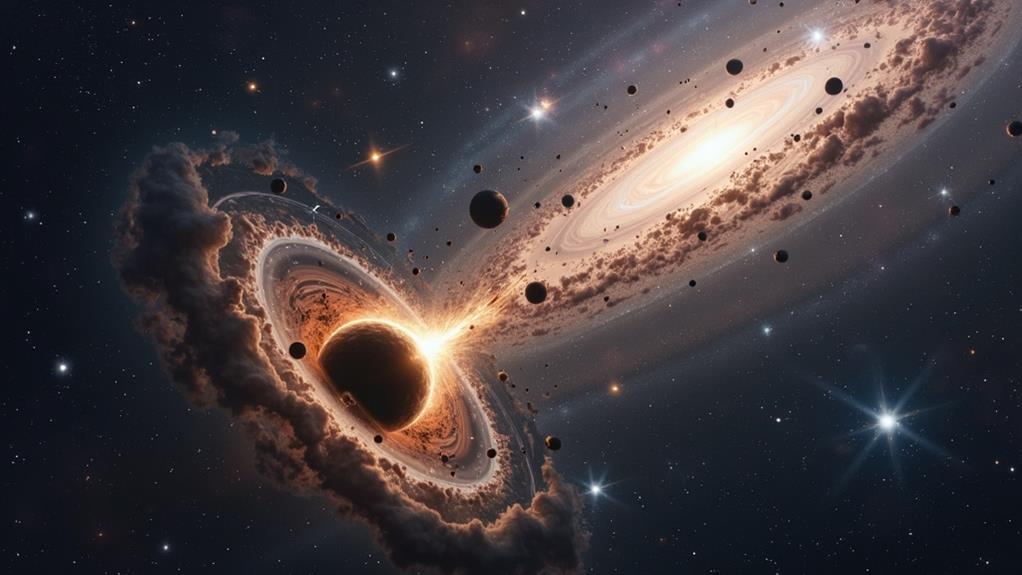
Black hole collisions don't happen often, and you can thank low-metallicity environments for that. These environments, which have a lower abundance of elements heavier than hydrogen and helium, are vital for the formation of black holes. In such low-metallicity regions, massive stars can form more easily. These stars, being the progenitors of black holes, can grow larger before they collapse.
During stellar evolution in low-metallicity environments, stars experience reduced mass loss. This reduced mass loss allows them to retain more mass, which is fundamental for forming black holes. The larger the star, the more likely it is to become a black hole, setting the stage for potential black hole mergers.
Interestingly, all three black hole merger events detected by LIGO are believed to have originated from low-metallicity progenitors. This connection underscores how environmental metal content directly influences black hole formation. The COMPAS model, which analyzes black hole progenitors, further supports this by showing that mass transfer episodes between stars are more common in low-metallicity environments. These episodes are significant for setting the conditions necessary for black hole mergers, making such cosmic collisions an extraordinary rarity.
Final Parse Problem
After exploring how low-metallicity environments pave the way for black hole mergers, let's tackle a more puzzling aspect of these cosmic events: the final parsec problem. This issue arises when supermassive black holes stall approximately 1 parsec apart due to complex gravitational dynamics. This stalling is a significant observational puzzle in black hole physics, as merging black holes are expected to eventually coalesce but often don't.
Current observations show that black holes are frequently found around 430 parsecs apart, indicating a significant gap that complicates merger processes. If the final parsec problem weren't a major obstacle, our universe might contain a substantial gravitational wave background from numerous black hole mergers. Here's why resolving this issue is vital:
- Understanding Gravitational Dynamics: Determining why supermassive black holes stall helps us comprehend the forces at play during mergers.
- Gravitational Wave Emissions: Without resolving this, we can't accurately predict the frequency and intensity of gravitational waves from black hole mergers.
- Observational Puzzle: This problem remains a long-standing mystery that challenges our current understanding of black hole behavior.
- Universe's Population of Black Holes: Solving it is key to knowing how many black holes have merged and their impact on the universe.
Observational Challenges
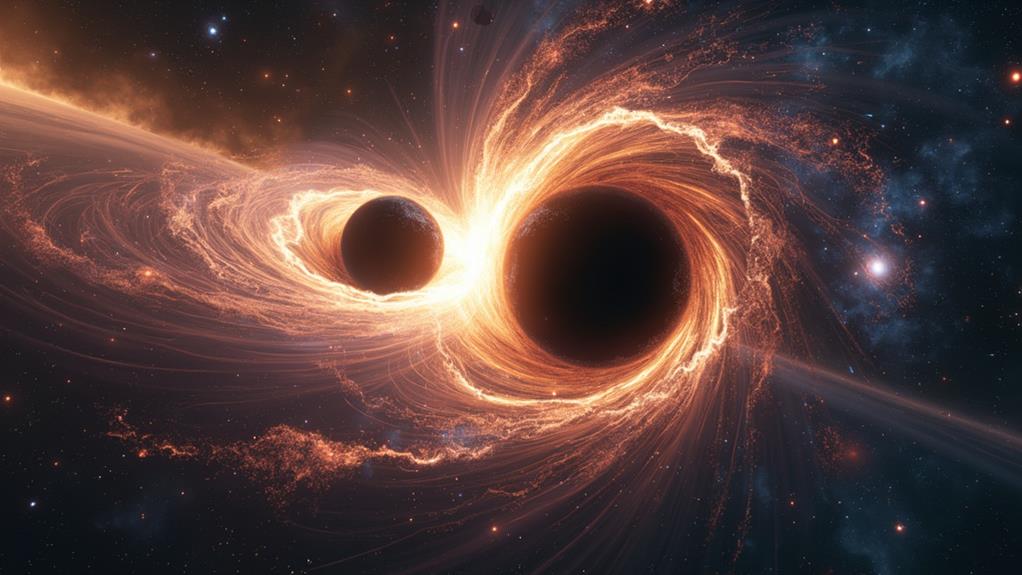
Given the vastness of space, observing black hole collisions poses significant challenges for astronomers. These events are rare and often occur billions of light years away, making them difficult to detect. Despite the identification of some black holes, the sheer distance and faintness of the signals they produce complicate observations.
One of the primary observational challenges is detecting gravitational waves from black hole mergers. These waves are incredibly faint and require highly sensitive detectors like LIGO. Since 2015, LIGO has only detected a limited number of these events, highlighting their rarity. Furthermore, the "final parsec problem" adds another layer of difficulty. Supermassive black holes can stall one parsec apart, preventing them from merging and consequently reducing the number of detectable events.
Advanced modeling and simulations are essential in overcoming these challenges. Tools like the COMPAS framework help astronomers predict potential mergers and understand why black hole collisions are so rare. Despite these efforts, the observational challenges remain significant, making each detected event a valuable opportunity for advancing our understanding of the cosmos.
Future Research Directions
Pioneering new approaches, future research will investigate deeper into the formation processes and merger environments of black holes, greatly enhancing our understanding of their evolutionary history. Utilizing the COMPAS model, scientists will examine how black holes form and the conditions that lead to their mergers. This research will be vital in addressing the final parsec problem, a significant hurdle in understanding the merger of supermassive black holes.
To help you grasp the exciting directions ahead, consider these key points:
- Simulation Dynamics: Ongoing simulations aim to clarify the dynamics of black hole mergers, offering insights into how these cosmic events unfold.
- Gravitational Waves: With upcoming detectors, future research will improve the precision of gravitational wave measurements, refining our predictions of black hole merger outcomes.
- Collaborative Efforts: Institutions worldwide, backed by funding from NASA and the National Science Foundation, will drive advancements through joint observational campaigns and shared data.
- Supermassive Black Holes: The anticipated detection of the gravitational wave background in the next five years will illuminate nearby supermassive black holes and their merger rates.
Future research in these areas promises to revolutionize our understanding of black holes and their complex interactions in the cosmos.
Public Perception and Misconceptions
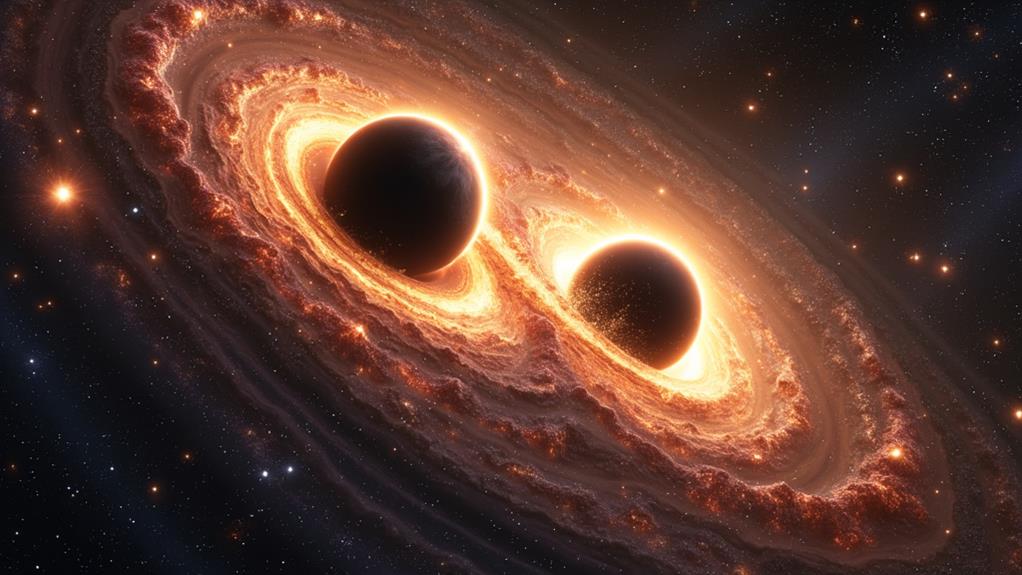
Many people have misconceptions about black holes, often viewing them as cosmic vacuum cleaners ready to consume everything in their path. This fear stems from the mistaken belief that black holes have an all-encompassing gravitational pull. In reality, their gravitational effects are limited to nearby celestial bodies. If our Sun were replaced by a black hole of the same mass, the orbits of the planets would remain unchanged.
Public misconceptions are fueled by films and media that exaggerate the size and danger of black holes. These portrayals make them seem like unstoppable forces, but black holes only affect objects that come very close. For instance, if you're a safe distance away, you'd be fine.
The rarity of black hole collisions is another aspect that's often misunderstood. Collisions require specific conditions, such as stars evolving in close proximity and undergoing mass transfer, which are not common across the universe. The gravitational waves detected from these rare events highlight their infrequency.
Educational outreach is essential for clarifying these points. By understanding that black holes' effects are significant only in their immediate surroundings, we can appreciate the true nature of these fascinating cosmic objects without unnecessary fear.
Frequently Asked Questions
Is It True That 2 Black Holes Collide?
Yes, two black holes can collide, like two dancers in a cosmic ballet. Black hole mergers are incredible astrophysical processes. They create massive gravitational waves and shake the universe. These cosmic phenomena occur in binary systems, often involving supermassive black holes. As they spiral towards each other, crossing the event horizon, they merge. But observing these events is challenging due to vast distances and the rarity of such colossal collisions.
What Are the Chances of a Black Hole Hitting Earth?
The chances of a black hole hitting Earth are astronomically low. Black hole frequency and cosmic events show that such collisions are rare. Detection methods and collision simulations indicate minimal risk. Gravitational waves and space-time distortions from nearby black holes haven't been observed near Earth. Theoretical implications suggest that the astronomical odds of a black hole impacting Earth are less than one in a trillion, making it extremely unlikely.
What Are Some Facts About Black Holes Colliding?
Imagine two dancers slowly spiraling towards each other, their dramatic final hug sending ripples across the universe. That's what happens during black hole collisions. Black hole formation often leads to these catastrophic events, producing gravitational waves detectable by instruments like LIGO. As they merge, they can create astrophysical jets and distort space-time around their event horizons. These cosmic dances occur across vast distances, sometimes involving supermassive black holes or even neutron star collisions.
When Was the Last Black Hole Collision?
The last black hole collision happened on May 21, 2020. Thanks to recent findings, gravitational waves from this cosmic event were detected by LIGO and Virgo. These detection methods highlight the astrophysical significance of such collisions. While the collision frequency is increasing, there are still observational challenges. Each new detection offers theoretical implications for our understanding of the universe, making these events essential for further study.

